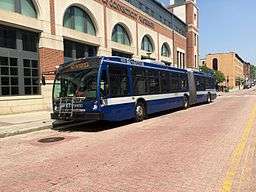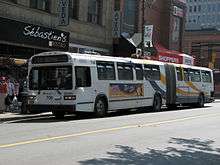Nova Bus
|
| |
 | |
| Subsidiary | |
| Industry | Transit |
| Predecessor |
Motor Coach Industries (transit) Transportation Manufacturing Corporation |
| Founded | 1993 |
| Headquarters | Saint-Eustache, Quebec, Canada |
Key people | Raymond Leduc (President) |
| Products | Public Transit buses |
| Owner | Volvo |
| Parent | Volvo Buses |
| Website |
www |
Nova Bus is a Canadian bus manufacturer in North America, owned by Volvo Buses, and headquartered in Saint-Eustache, Quebec, Canada.
History
Nova Bus's Saint-Eustache factory was built as a General Motors plant for building city transit buses for the Canadian market. In 1987 GM sold its bus-building holdings to Motor Coach Industries (MCI), which had been formed from companies that had been owned by Greyhound Lines. The plant was used to produce the Classic model for sales in Canada, while GMC's Rapid Transit Series (RTS) product was moved to join MCI's own designs at Transportation Manufacturing Corporation in Roswell, New Mexico. MCI divested its urban rapid transit models in 1993, and Nova Bus was created to continue producing the Classic and RTS models at the Saint-Eustache and Roswell plants respectively.
The Classic and RTS were later discontinued in order to concentrate on the Nova LFS, a low floor city bus, which was introduced in 1995. The last Classic model was produced in 1997. Sales of Nova LFS were insufficient and Nova Bus closed its Roswell and Niskayuna, New York plants in 2002 to concentrate all efforts on the Canadian market. The Roswell plant was later acquired by a local consortium, Millennium Transit Services, that almost went bankrupt in 2008, then emerged from bankruptcy in 2011. The Chicago Transit Authority (CTA), with 480 LFS units in its active bus fleet, remains one of the larger operators of Nova Buses.
On February 2, 2008, Nova Bus announced plans for the construction of a new assembly plant in Plattsburgh, New York, signifying the company's return to the U.S. bus market. The plant opened for business on June 15, 2009.[1] Its first US order under American production came from the New York City Transit Authority for 90 LFS Articulated buses (counting LFS rigids operated by the same agency, the NYCTA now counts nearly 500 LFS buses in its active fleet). In March 2010, Nova Bus received the first US-built order for its redesigned LFS from Honolulu, Hawaii's TheBus. The 24 buses arrived in December 2010; there were plans to order more in the future, but since then TheBus chose to go with Gillig instead.[2] In March 2012 the Walt Disney Company announced that it plans to test a Nova articulated bus on certain high traffic routes at the Walt Disney World Resort. In 2012 the Southeastern Pennsylvania Transportation Authority (SEPTA) placed an order for 315 buses which included 225 articulated buses to replace its aging Neoplan AN460 articulated buses and its remaining North American Bus Industries NABI 416 standard buses. [3] In 2014 SEPTA rolled out its new Nova Bus LFS HEV 62-102 articulated buses onto the streets of Philadelphia on October 27, 2014. [4] In 2013 CTA placed an order for 300 40 foot Nova Bus clean-diesel buses, with an option to buy an additional 150. [5]
Products
Current

The rigid LFS entered mass production in 1995, and the LFS Artic and LFX (articulated bus rapid transit model) were introduced in 2009. The standard LFS is also available in a single-door commuter configuration. Both the rigid and articulated versions of the LFS/LFX are available with a hybrid drivetrain that uses an Allison EP40/EP50 parallel hybrid system. These options were first delivered in 2007 to Société de transport de l'Outaouais (STO) in Gatineau, Quebec (40-foot model) annod in 2011 to Connecticut Transit (62-foot articulated model). In October 2011, the rear window became an option.
The original powertrain layout mounted on the left at the rear was changed to a center-mounted powertrain, with ventilation through the roof on all LFS models starting in 2009. However, some demonstrators and test buses were built in 2008 with this update. In 2013 a new fourth generation rear layout was introduced and became standard mid 2013. Some early 2013 models were delivered with the third generation rear.
Past
| Model | Length | Width | Photo | Years Produced | Notes |
|---|---|---|---|---|---|
| Rapid Transit Series (RTS) | 9.14 m (30 ft) 10.67 m (35 ft) |
2.44 m (96 in) 2.59 m (102 in) |
 |
1995–2004 |
|
| TC40102A TC40102N |
12.19 m (40 ft) | 2.59 m (102 in) |  |
1993–1997 |
|
| TC60102N | 18.29 m (60 ft) | 2.59 m (102 in) |  |
1993 |
|
See also
| Wikimedia Commons has media related to Nova Bus. |
References
- ↑ "Bus-assembly plant proposed for Plattsburgh", The Press Republican
- ↑ Press release from Nova Bus (March 11, 2010)
- ↑ "SEPTA plannning to buy 245 new buses". philly.com. Retrieved 2014-11-08.
- ↑ "SEPTA Rolls Out Hybrid Buses in Philly". nbcphiladelphia.com. Retrieved 2014-11-08.
- ↑ "CTA Approved to Purchase 300 New Clean Diesel Buses". transitchicago.com. Retrieved 2015-02-15.